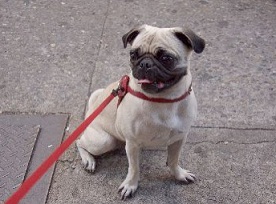
Determining the proper length of the collar is a fairly easy task. Simply wrap a tape measure or a string loosely around your dog's neck to get an accurate measurement. It is important that the tape measure is not to tight, just slightly snug.
In general collars are sized in two inch increments, so you may have to round up to get a properly sized collar. For instance, if the dog has a 13" neck, you would buy a 14" collar, if your dog is a puppy this will also allow for some growth. After you have purchased the correct collar, the next step is to put it on your dog and allow him to wear it around the house for a while. Do not be upset if the dog cries, paws at the collar or even tries to remove it. This is normal behavior, and the dog should not be punished for it.
The dog should be allowed to wear the collar 24 hours a day for a number of days to get used to the feel of the collar on his neck. After the dog is accepting the collar, it is time to start introducing the leash. A lightweight leash works best and is recommended for this process. Simply attach the leash to your dog's collar and allow him to walk around the house with it. The dog should be supervised during this process in order to make sure he does not get the leash caught on any furniture or breakable items. Getting the leash caught or snagged could frighten or hurt your dog or create a leash phobia that will be hard to overcome.
When beginning, the leash should only be attached for a few minutes at a time. It is important to attach the leash at happy times, such as playtime, meal time, etc. It is very important for your dog to associate the leash with fun things. When the leash is not attached to your dog, it is an excellent idea to keep it near the dog's food and water bowls. The dog should be encouraged to sniff or investigate the leash, and to discover that it is not something to fear.
After your dog is used to walking around the house with the leash attached, take the end of the leash in your hand and just hold it. Allow your dog to walk around. If your dog bumps into the end of the leash (which he will), just allow him to react and move as he desires. The goal of this exercise is to simply allow your dog to get used to the feel of the collar and the leash together.
It is important to allow your puppy plenty of time to get used to wearing the collar and leash before you ever attempt to lead the puppy. It is always best to perform this exercise in the home or other environment where the puppy feels safe and secure. After the puppy is comfortable and content walking on the leash in the home, you will be able to slowly take him outside. It is best to start these outside trips very short at the beginning, and to slowly lengthen them over time. It is important to remember that some puppies take to the collar and leash immediately, while others may require some additional time.




